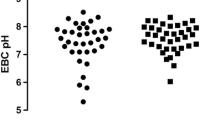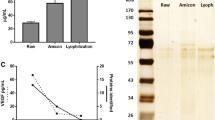Abstract
Purpose
This study was designed to assess exhaled hydrogen peroxide (H2O2), blood serum antioxidant capacity, and tumor necrosis factor-α (TNFα) in primary breast cancer (PBC).
Methods
The study included 34 consecutive, non-smoking PBC patients (aged 62.5 ± 13.5 at surgery) prior to the treatments, qualified for modified radical mastectomy and not undergoing any adjuvant systemic therapy, and 33 healthy controls. The post surgery pathological assessment included tissue expression of estrogen (ER) and progesterone (PR) receptors, and epidermal growth factor receptor type 2 (HER-2/neu). Exhaled H2O2 was determined fluorometrically in the exhaled breath condensate (EBC). Blood serum antioxidant capacity and TNFα levels were assessed with ferric reducing ability of plasma (FRAP) and ELISA immunoassay, respectively.
Results
In PBC patients, 10 ER, 11 PR, and 9 HER-2/neu positive tumors were identified and HER-2/neu score was 2+ in 20% of all tumors. Median (Me) H2O2 was increased up to 0.44 μM (interquartile range IR: 0.20–1.25 μM) compared with healthy control of 0.36 μM (IR: 0.12–0.48 μM; p < 0.05). The H2O2 concentration in EBC was significantly correlated (τ = 0.27; p = 0.03) and increased in cases with nodal metastases (n = 12; p = 0.04). Serum TNFα was increased up to 51.7 ± 21.0 pg/ml compared with controls 17.2 ± 3.65 pg/ml (p < 0.05). FRAP was increased to 1.41 ± 0.37 mM Fe2+ compared with control 1.19 ± 0.17 mM Fe2+; (p = 0.006).
Conclusions
This is the first study to demonstrate increased H2O2 in exhaled breath condensate in patients with localized breast malignancy and its relation with clinical severity.

Similar content being viewed by others
Abbreviations
- EBC:
-
Exhaled breath condensate
- FRAP:
-
Ferric reducing ability of plasma
- HER:
-
-2/neu human epidermal growth factor cell surface receptor-2
- IHC:
-
Immunohistochemistry
- PBC:
-
Primary breast cancer
- ROS:
-
Reactive oxygen species
References
Adzic M, Niciforovic A, Vucic V, Neskovic-Konstantinovic Z, Spasic SD, Jones DR, Radojcic MB, Spasic MB (2006) Systemic NF-kappaB activation in blood cells of breast cancer patients. Redox Rep 11:39–44
Bae I, Fan S, Meng Q, Rih JK, Kim HJ, Kang HJ, Xu J, Goldberg I, Jaiswal AK, Rosen EM (2004) BRCA1 induces antioxidant gene expression and resistance to oxidative stress. Cancer Res 64:7893–7909
Balogh N, Gaal T, Ribiczeyne PS, Petri A (2001) Biochemical and antioxidant changes in plasma and erythrocytes of pentathlon horses before and after exercise. Vet Clin Pathol 30:214–218
Benzie IFF, Strain JJ (1996) The ferric reducing ability of plasma (FRAP) as a measure of ‘antioxidant power’: the FRAP assay. Anal Biochem 239:70–76
Carney WP, Leitzel K, Ali S, Neumann R, Lipton A (2007) HER-2/neu diagnostics in breast cancer. Breast Cancer Res 9:207
Dasari A, Bartholomew JN, Volonte D, Galbiati F (2006) Oxidative stress induces premature senescence by stimulating caveolin-1 gene transcription through p38 mitogen-activated protein kinase/Sp1-mediated activation of two GC-rich promoter elements. Cancer Res 22:10805–10814
De Benedetto F, Aceto A, Dragani B, Spacone A, Formisano S, Pela R, Donner CF, Sanguinetti CM (2005) Long-term oral N-acetylcysteine reduces exhaled hydrogen peroxide in stable COPD. Pulm Pharmacol Ther 18:41–47
de Cavanagh EM, Honegger AE, Hofer E, Bordenave RH, Bullorsky EO, Chasseing NA, Fraga C (2002) Higher oxidation and lower antioxidant levels in peripheral blood plasma and bone marrow plasma from advanced cancer patients. Cancer 94:3247–3251
Degraft-Johnson J, Kolodziejczyk K, Krol M, Nowak P, Krol B, Nowak D (2007) Ferric-reducing ability power of selected plant polyphenols and their metabolites: implications for clinical studies on the antioxidant effects of fruits and vegetable consumption. Basic Clin Pharmacol Toxicol 100:345–352
Fan C, Oh DS, Wessels L, Weigelt B, Nuyten DS, Nobel AB, van’t Veer LJ, Perou CM (2006) Concordance among gene-expression-based predictors for breast cancer. N Engl J Med 355:560–569
Garcia-Tunon I, Ricote M, Ruiz A, Fraile B, Paniagua R, Royuela M (2006) Role of tumor necrosis factor-alpha and its receptors in human benign breast lesions and tumors (in situ and infiltrative). Cancer Sci 97(10):1044–1049
Gaudet MM, Egan KM, Lissowska J, Newcomb PA, Brinton LA, Titus-Ernstoff L, Yeager M, Chanock S, Welch R, Peplonska B, Trentham-Dietz A, Garcia-Closas M (2007) Genetic variation in tumor necrosis factor and lymphotoxin-alpha (TNF-LTA) and breast cancer risk. Hum Genet 121:483–490
Gerristen WB, Asin J, Zanen P, van der Bosch JM, Haas FJ (2005) Markers of inflammation and oxidative stress in exacerbated chronic obstructive pulmonary disease patients. Respir Med 99:84–90
Hietanen E, Bartsch H, Bereziat JC, Camus AM, McClinton S, Eremin O, Davidson L, Boyle P (1994) Diet and oxidative stress in breast, colon and prostate cancer patients: a case–control study. Eur J Clin Nutr 48:575–586
Kasapović J, Pejić S, Todorović A, Stojiljković V, Pajović SB (2008) Antioxidant status and lipid peroxidation in the blood of breast cancer patients of different ages. Cell Biochem Funct 26:723–730
Korkaya H, Paulson A, Iovino F, Wicha MS (2008) HER2 regulates the mammary stem/progenitor cell population driving tumorigenesis and invasion. Oncogene 27:6120–6130
Kostikas K, Papatheodorou G, Psathakis K, Panagou P, Loukides S (2003) Oxidative stress in expired breath condensate of patients with COPD. Chest 124:1373–1380
Koutsokera A, Loukides S, Gourgoulianis KI, Kostikas K (2008) Biomarkers in the exhaled breath condensate of healthy adults: mapping the path towards reference values. Curr Med Chem 15:620–630
Kuo PL, Hsu YL, Lin TC, Tzeng WS, Chen YY, Lin CC (2006) Rugosin E, an ellagitannin, inhibits MDA-MB-231 human breast cancer cell proliferation and induces apoptosis by inhibiting nuclear factor-kappaB signaling pathway. Cancer Lett 259:82–98
Loukides S, Bouros D, Papatheodorou G, Panagou P, Siafakas NM (2002) The relationships among hydrogen peroxide in expired breath condensate, airway inflammation, and asthma severity. Chest 121:338–346
Luo Y, Zhou H, Krueger J, Kaplan C, Lee SH, Dolman C, Markowitz D, Wu W, Liu C, Reisfeld RA, Xiang R (2006) Targeting tumor-associated macrophages as a novel strategy against breast cancer. J Clin Invest 116:2132–2141
Miller MR, Hankinson J, Brusasco V, Burgos F, Casaburi R, Coates A, Crapo R, Enright P, van der Grinten CP, Gustafsson P, Jensen R, Johnson DC, MacIntyre N, McKay R, Navajas D, Pedersen OF, Pellegrino R, Viegi G, Wanger J, ATS/ERS Task Force (2005) Standardisation of spirometry. Eur Respir J 26:319–338
Moore A (2007) Breast-cancer therapy—looking back to the future. N Engl J Med 357:1547–1549
Nass SJ, Davidson NE (1999) The biology of breast cancer. Hematol Oncol Clin North Am 13:311–332
Nowak D, Kasielski M, Antczak A, Pietras T, Bialasiewicz P (1999) Increased content of thiobarbituric acid-reactive substances and hydrogen peroxide in the expired breath condensate of patients with stable chronic obstructive pulmonary disease: no significant effect of cigarette smoking. Respir Med 93:389–396
Phillips M, Cataneo RN, Ditkoff BA, Fisher P, Greenberg J, Gunawardena R, Kwon CS, Rahbari-Oskoui F, Wong C (2003) Volatile markers of breast cancer in the breath. Breast J 9:184–191
Phillips M, Cataneo RN, Ditkoff BA, Fisher P, Greenberg J, Gunawardena R, Kwon CS, Tietje O, Wong C (2006) Prediction of breast cancer using volatile biomarkers in the breath. Breast Cancer Res Treat 99:19–21
Rysz J, Kasielski M, Apanasiewicz J, Król M, Woźnicki A, Luciak M, Nowak D (2004) Increased hydrogen peroxide in the exhaled breath of uraemic patients unaffected by haemodialysis. Nephrol Dial Transplant 19:158–163
Rysz J, Stolarek RA, Pedzik A, Fijalkowska J, Luczynska M, Sarniak A, Kasielski M, Makowka A, Nowicki M, Nowak D (2007) Increased exhaled H2O2 and impaired lung function in patients undergoing bioincompatible hemodialysis. Int J Artif Organs 30:879–888
Schmielau J, Finn OJ (2001) Activated granulocytes and granulocyte-derived hydrogen peroxide are the underlying mechanism of suppression of T-Cell function in advanced cancer patients. Cancer Res 61:4756–4760
Stolarek R, Szkudlarek U, Luczynska M, Kasielski M, Ciesla W, Lewinski A, Nowak D (2008) Decreased H2O2 in exhaled breath condensate during pregnancy-feasible effect of 17beta-estradiol. Respir Physiol Neurobiol 162:152–159
Szkudlarek U, Maria L, Kasielski M, Kaucka S, Nowak D (2003) Exhaled hydrogen peroxide correlates with the release of reactive oxygen species by blood phagocytes in healthy subjects. Respir Med 97:718–725
Xu J, Zhou JY, Wu GS (2006) Tumor necrosis factor-related apoptosis-inducing ligand is required for tumor necrosis factor alpha-mediated sensitization of human breast cancer cells to chemotherapy. Cancer Res 66:10092–10099
Yau C, Benz CC (2008) Genes responsive to both oxidant stress and loss of estrogen receptor function identify a poor prognosis group of estrogen receptor positive primary breast cancers. Breast Cancer Res 10:R61
Zhang J, Warren MA, Shoemaker SF, Ip MM (2007) NFkappaB1/p50 is not required for tumor necrosis factor-stimulated growth of primary mammary epithelial cells: implications for NFkappaB2/p52 and RelB. Endocrinology 148:268–278
Conflict of interest statement
None.
Author information
Authors and Affiliations
Corresponding author
Rights and permissions
About this article
Cite this article
Stolarek, R.A., Potargowicz, E., Sęklewska, E. et al. Increased H2O2 level in exhaled breath condensate in primary breast cancer patients. J Cancer Res Clin Oncol 136, 923–930 (2010). https://doi.org/10.1007/s00432-009-0734-x
Received:
Accepted:
Published:
Issue Date:
DOI: https://doi.org/10.1007/s00432-009-0734-x




